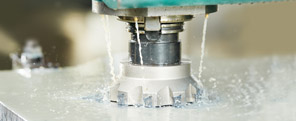 |
|||||||
|
A quality metalworking fluid is essential, however it accounts for less than 10 percent of the fluid used in machining processes. The other 90 percent is water. Unfortunately, water composition varies greatly, depending on the source. Just as a team athlete's success often depends on the performance of others, the effectiveness of a metalworking fluid is enhanced or inhibited by the quality of water. Water may contain a myriad of chemicals and microorganisms capable of adversely affecting the ability of metalworking fluids to do their work. Water composition largely depends on geographical location. Midwest locations must compensate for extremely hard water, while coastal areas, or areas in the South often work with extremely soft water. Soft water may inhibit the performance of metalworking fluids by promoting the formation of foam. Excess foam leads to a host of problems including inadequate wetting and coverage, which inhibits lubrication, cooling, and corrosion protection. Typical hard water problems include:
Pure water is an ideal avoidance strategy for water quality problems, but may also be cost-prohibitive. Locally treated water is often acceptable for metalworking concentrate mixtures used in the initial charge. However, when fluids are recycled to promote efficiency and green initiatives, a quality problem may occur with make-up water. As the importance of water quality becomes more widely recognized, effective water treatment solutions are becoming more available. The two most cost-efficient and widely used processes are deionization and reverse osmosis. Deionization removes minerals by passing the water through a mixed resin bed and reduces hardness levels to almost zero ppm. Reverse osmosis forces water through a semi-permeable membrane under high pressure and varying flow conditions, eliminating as much as 95 percent of dissolved minerals. Water quality's impact on the effectiveness of metalworking fluids is all the more compelling in light of recent regulations regarding the treatment of wastewater. For objective advice on water quality issues related to metalworking processes, it's smart to talk with Acculube, an experienced supplier of metalworking fluids who can assist with ideas that will deliver the best machining results while minimizing machine downtime and other costs.
|

|
||||||
|
|||||||
|
|||||||
Accurate Lubricants & Metalworking Fluids, Inc.• 403 Homestead Avenue; Dayton, Ohio 45417 USA • Phone: 937-461-9906 Fax: 937-461-9917
|
|||||||
